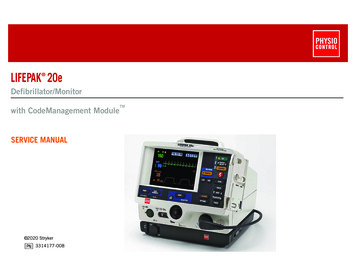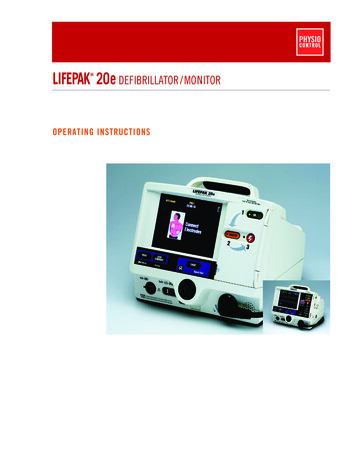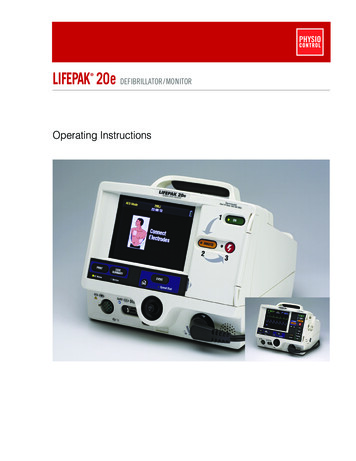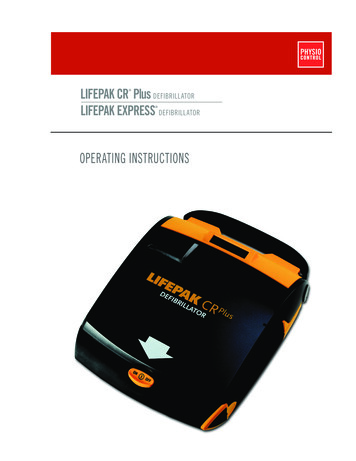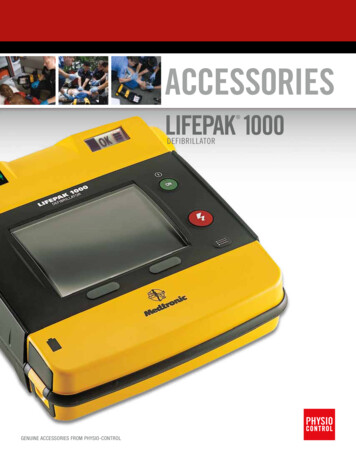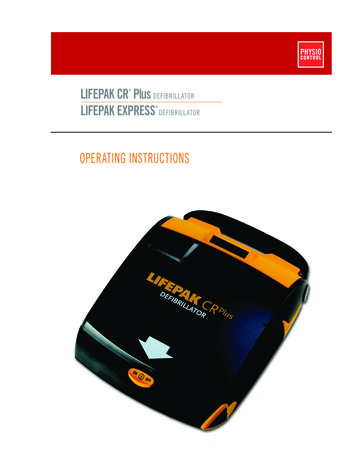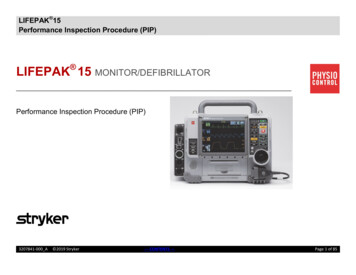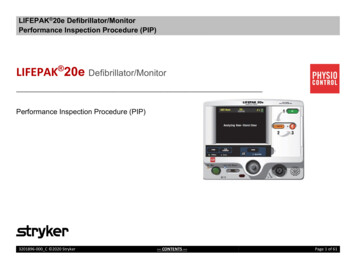
Transcription
LIFEPAK 20e Defibrillator/MonitorPerformance Inspection Procedure (PIP)LIFEPAK 20e Defibrillator/MonitorPerformance Inspection Procedure (PIP)3201896-000 C 2020 Stryker--- CONTENTS ---Page 1 of 61
LIFEPAK 20e Defibrillator/MonitorPerformance Inspection Procedure (PIP)This Performance Inspection Procedure (PIP) is a set of manual test procedures which are used as an operational closed-case evaluation ofthe LIFEPAK 20e Defibrillator/Monitor. This section describes contents of the test procedures you will perform to determine if the device isoperating within the required specifications.Perform the PIP as part of a regularly scheduled preventive maintenance routine. Also, perform the PIP after any repair, replacement, orcalibration procedure. The Performance Inspection Procedure Checklist is provided as a tool for the recording of PIP test results.Contents:PIP - Scope and ApplicabilityPIP - Resource RequirementsPIP - Test EquipmentPIP - Test Equipment VerificationPIP - Workstation PowerPIP - Test Equipment RequirementsPIP - Test InstructionPIP - General InstructionPIP - Exterior Physical Inspection/Cleaning PaddlesPIP - Device SetupPIP - Manual Mode AccessPIP - Power On/Self-TestPIP - User Test and Date/Time Verification TestPIP - SpO2PIP - Keypad Verification TestsPIP - Pixels Verification TestPIP - Audio Verification TestPIP - Printer Verification TestsPIP - ECG Performance Testing3201896-000 C 2020 Stryker--- CONTENTS ---Page 2 of 61
LIFEPAK 20e Defibrillator/MonitorPerformance Inspection Procedure (PIP)PIP- 3-Lead ECG TestsPIP - 3-Lead ECG Leads Off Detection TestPIP - 3-Lead ECG Gain TestPIP - 5-Lead ECG TestsPIP- 5-Lead ECG Leads Off Detection TestPIP- 5-Lead ECG Gain TestPIP- Analog ECG Output (Optional Test)PIP- Defibrillator/Pacing TestingPIP - Quik-Combo Defibrillator Sync Tests at 2JPIP - QUIK-COMBO Defibrillator Delivered Energy Tests at 2J and 70 JPIP - Quik-Combo Defibrillator Delivered Energy and Charge Time Tests at 360 J (Battery Powered)PIP - Quik-Combo Defibrillator ECG Characteristic TestsPIP - QUIK-COMBO Defibrillator ECG Gain TestPIP - QUIK-COMBO Defibrillator a Positive R-wave TestPIP - Quik - Combo Sync Remote TestPIP - Standard Paddles Users TestPIP - Standard Paddles Defibrillator Sync Test at 2JPIP - Standard Paddles Defibrillator Delivered Energy Tests at 2J and 70JPIP - Standard Paddles Defibrillator Delivered Energy and Charge Time Tests at 360 J (Battery Powered)PIP - Standard Paddles ECG Characteristic TestsPIP - Standard Paddles Defibrillator ECG Gain TestPIP - Standard Paddles Defibrillator a Positive R-wave TestPIP - Standard Paddles Sync Remote TestPIP - Pacer Characteristic TestsPIP - Pacer Leads-Off Detection TestPIP - Pacer Output Current TestPIP - Pacer Pulse Width TestPIP - Patient Impedance Test3201896-000 C 2020 Stryker--- CONTENTS ---Page 3 of 61
LIFEPAK 20e Defibrillator/MonitorPerformance Inspection Procedure (PIP)Electrical SafetyPIP- Safety Analyzer Setup for IEC62353 TestingPIP- Protect Earth Resistance TestPIP - Leakage Current TestPIP - Leakage Current Test SetupPIP- Direct Equipment Leakage Test at Single Fault Condition (SFC)PIP- Safety Analyzer Setup on Direct Applied Part Leakage TestsPIP- Direct Applied Part Leakage Test - ECGPIP- Direct Applied Part Leakage Test -TherapyPIP- Direct Applied Part Leakage Test -SPO2PIP - Safety Analyzer Setup on Earth Leakage TestsPIP- Earth Leakage Test at Normal Condition (NC)PIP- Earth Leakage Test at Single Fault Condition (SFC)PIP- Restore Customer Setting3201896-000 C 2020 Stryker--- CONTENTS ---Page 4 of 61
LIFEPAK 20e Defibrillator/MonitorPerformance Inspection Procedure (PIP)Scope and ApplicabilityThe PIP applies to the LIFEPAK 20e Defibrillator/Monitor exclusively. To complete the PIP, you must perform the manual test outlinedin the PIP - Instructions below. All PIP tests must be performed from start to finish in the order presented.Refer to the PIP - Resource Requirements for a listing of the necessary qualifications for PIP equipment, test equipment verification,workstation power.Refer to the PIP - Test Equipment Requirements for a listing of test equipment, including specifications, required to complete the PIP.Use the PIP - Checklist to record your results.Resource RequirementsThis section describes the requirements for PIP equipment, PIP test equipment verification, PIP workstation power.Test EquipmentTo perform the PIP, you must use the equipment listed in the PIP - Test Equipment Requirements table. Although the table listsspecific test equipment by manufacturer, test equipment with equivalent specifications may be substituted. Refer to the test equipmentmanufacturer’s operating instructions for usage details where not specifically covered herein.Test Equipment VerificationAll test equipment used to perform the PIP must have a current calibration label. The calibration label must be issued by a certifiedcalibration facility.Workstation PowerThe AC line power to the workstation must be connected to a grounded power source.3201896-000 C 2020 Stryker--- CONTENTS ---Page 5 of 61
LIFEPAK 20e Defibrillator/MonitorPerformance Inspection Procedure (PIP)Test Equipment RequirementsEquipmentSpecification or DescriptionDefibrillator analyzer with external noninvasivepacer measurements*Energy range: 0 to 450 JLoad resistance: 50ohms 1% Accuracy: /- 2%, noninductiveWaveforms: Simultaneous 12-lead outputRates: 30 bpm, 120 bpm, with rateaccuracy of 1% Amplitude: 1 mV 5%, based on Lead IIECG performance: Amplitudes of Lead II andLeads V1-V6 are equivalent. Lead I 70%amplitude of Lead II.Sine wave: 10 Hz @ 1 mV 2%, based onLead IISafety Analyzer90 V ac rms to 264 V ac rms mains voltageCurrent range: 0-1999 µACurrent accuracy: 5% of reading or 1 digit(whichever is greater)0 to 9 MΩ resistance boxResolution: 1 Ω; accuracy: 1%Decade resistance boxRemote Sync Test Pulse Generator***Fluke Biomedical Impulse7000DP with QUIK-COMBOadapter accessory 16/7 D/PADPT104**Fluke Biomedical ESA612*IET RS-200 Resistance Substitute*21300-00757421300-007561, 30-00003711110-00004011240-000013SPO2 Leakage CableAC Power CableAccessory –Test Plug, Quik-ComboPaddle Assembly - Detachable, LP20QUIK-COMBO Therapy Cable50 mm Recorder Paper3201896-000 C 2020 StrykerManufacturer or Part number orCatalog number--- CONTENTS ---Page 6 of 61
LIFEPAK 20e Defibrillator/MonitorPerformance Inspection Procedure (PIP)EquipmentSpecification or DescriptionDB9 Male/DB 9 Female cable (optional)Masimo Oximeter Adult finger sensor (LNOP DCI,Adult SPO2 sensor, reusable)Massimo Extension Cable (PC04-Patient Cable,SPO2, 4ft)Cable Assembly, Fast Patch (use for 7000DP andRS200)Electrode test posts (use for 7000DP and RS200)Manufacturer or Part number orCatalog 330-001372Cable, Test, Service, LP 0-0000673009139320663133056843207066Fluke 1210Cable Assembly, 3 Lead ECGCable Assembly, 5 Lead ECGCable Assembly, Analog ECG OutputCable, QUIK-COMBO to Snap TerminationAdapter -Test, Paddles, Leakage, LP12 & LP20Cable, Test, ECG snap to banana plugQUIK-COMBO Leakage Cable1210 Adapter (for ESA612)BJ2 ECG Input Jack Adapter (1 for ESA612 and 2for 1210 Adapter)Banana plug cable (connect between ESA612and Battery eliminators)Fluke - BJ2Fluke ESA612 Accessory kit*Some energy meters are not accurate for biphasic waveforms; contact your defibrillator analyzer’s manufacturer for more information.**Equivalent equipment is required to meet the specifications listed in the specification column.***A function generator can be used alternatively to the Remote Sync Test Pulse Generator.3201896-000 C 2020 Stryker--- CONTENTS ---Page 7 of 61
LIFEPAK 20e Defibrillator/MonitorPerformance Inspection Procedure (PIP)Test InstructionsPIP - General Instruction This section lists the general instructions for performing the Performance Inspection Procedure (PIP). Perform the PIP in the order presented. Use the Performance Inspection Procedure Checklist to record your results.WARNINGPOSSIBLE EQUIPMENT DAMAGEOnly use accessories approved by Physio-Control.3201896-000 C 2020 Stryker--- CONTENTS ---Page 8 of 61
LIFEPAK 20e Defibrillator/MonitorPerformance Inspection Procedure (PIP)PIP - Exterior Physical Inspection/Cleaning PaddlesTo perform an exterior physical inspection:1. Inspect the LIFEPAK 20e exterior for the following: Damage, excessive wear, improper mechanical function, and damagedconnectors.2. Pick up and turn over the device and listen for loose or rattling hardware. Locate any loose or rattling hardware, and then tighten orreplace it.3. Inspect the rubber feet on the underside of the lower enclosure. Reinstall or replace rubber feet as necessary.4. Inspect the Therapy, ECG, SpO2 (if equipped), DB-9, DB-15, AED door, and IrDA connectors for damage and or cracks.5. Inspect the keypads and overlays for damage, cracks, and separations.6. Check all other accessory cables, Paddles, ECG, SpO2 sensors, and related items for expiration dates, general condition, andsuitability for use.7. Inspect carrying strap and mounts (if the device is equipped with them).To perform Cleaning Paddles:1.2.3.4.Disconnect the adult paddle plate from the paddle assembly.Clean the spring contact of the adult paddle with alcohol.Clean the pediatric electrode surface with alcohol.Reattach the adult paddle plate to the paddle assembly.3201896-000 C 2020 Stryker--- CONTENTS ---Page 9 of 61
LIFEPAK 20e Defibrillator/MonitorPerformance Inspection Procedure (PIP)PIP - Device SetupWARNINGSHOCK HAZARDThe defibrillator delivers up to 360 joules of electrical energy. Unless properly used as described in these operatinginstructions, this energy may cause serious injury or death. Do not attempt to operate this device unless thoroughly familiarwith these operating instructions and the function of all controls, indicators, connectors, and accessories.1. Connect the AC Power cable into the device.2. Install a roll of printer paper into the printer.Figure 1.1: Device Setup3201896-000 C 2020 Stryker--- CONTENTS ---Page 10 of 61
LIFEPAK 20e Defibrillator/MonitorPerformance Inspection Procedure (PIP)PIP - Manual Mode AccessIt is recommended that the device be set up for Manual mode when performing the PIP.Note: If you do not wish to change the setup for a device configured with manual access restrictions, it may be necessary to use thereserved technician passcode of 5433 to gain access to Manual mode.Note: Be sure to make note of the customer settings to restore the device to the user-selected MANUAL ACCESSconfiguration at the completion of this PIP.To perform the device for Manual mode access:1. Access the Setup mode as follows:a. Press and hold OPTIONS and EVENT, and then turn the device ON.b. When the Setup mode passcode prompt appears enter 5433.2. Select MANUAL MODE in the Setup menu.3. In the Setup/Manual Mode submenu, set the Manual Access selection toManual/Direct as shown in Figure 1.2.4. Turn the device OFF by pressing ON for two seconds.Figure 1.2: Manual Mode Access3201896-000 C 2020 Stryker--- CONTENTS ---Page 11 of 61
LIFEPAK 20e Defibrillator/MonitorPerformance Inspection Procedure (PIP)PIP - Power Self-TestTo perform the Power On/Self-Test:1. Press the ON button to initiate the device nominal five-second power-on selftest routine. Listen for a single tone from the speaker and then three distinctbeeps from the sonalert (AC loss alert).2. Verify that all lamps light momentarily except for the ON and AC mainsindicators which remain on throughout self-test.Note: The initial display indicates self-test in progress, as shown inFigure 1.3.3. Verify that the device completes the Power On sequence.4. Verify that AC Main indicator remains ON.5. Verify that the SERVICE INDICATOR is OFF.3201896-000 C 2020 Stryker--- CONTENTS ---Figure 1.3: Power Self -TestPage 12 of 61
LIFEPAK 20e Defibrillator/MonitorPerformance Inspection Procedure (PIP)PIP - User Test and Date/Time Verification TestsTo perform the User Test and Date/Time Verification Tests:1.2.3.4.Connect the Quik-Combo and Test Plug into the device.Turn the device ON.Press OPTIONS to access the Options menu.Select USER TEST from the Option menu. When asked to Start user test.Select Yes and confirm using the Speed Dial.5. Confirm the printed results that the device passes the user test and that thecorrect date and time values are displayed on the printout as shown inFigure 1.4.Note: If the date and time are incorrect, reset using theOptions/Date/Time menu.6. Turn the device OFF.3201896-000 C 2020 Stryker--- CONTENTS ---Figure 1.4: User Test and Date/TimePrintoutPage 13 of 61
LIFEPAK 20e Defibrillator/MonitorPerformance Inspection Procedure (PIP)PIP - SPO2 TestTo perform SPO2 Test :1.2.3.4.5.6.7.8.Turn the device ON.Connect the SpO2 finger probe to the SpO2 connector as shown in Figure 1.5.Verify the SpO2 parameter region appears on the display.Place your index finger into the SpO2 finger probe. Allow several seconds for the probe tofind your pulse.Confirm the SpO2 reading is between 50 % to 100 %.Remove finger from SpO2 finger probe. Message should display on screen: SpO2 CheckSensor with audible alarm.Unplug SpO2 finger probe from the device; while on current patient record, message shoulddisplay: SpO2 No Sensor Detected.Note: Alarms will clear when device is turned off and new patient record started the nexttime the device is turned on again.Turn the device OFF.Figure 1.5: SPO2 Test3201896-000 C 2020 Stryker--- CONTENTS ---Page 14 of 61
LIFEPAK 20e Defibrillator/MonitorPerformance Inspection Procedure (PIP)PIP - Keypad Verification TestsTo perform Keypad Verification Tests:1. Select TESTS in the Service menu.2. Select BUTTONS in the Service/Tests submenu as shown in Figure 1.6.3. Press each front panel button when prompted by the flashing buttonlegend (although you may press the buttons in any order).4. Verify with each button pressed that its associated text box is highlighted.Note: A failure is indicated by a text box that is not highlighted. It isnormal for the buttons with up/down arrows to highlight only thearrows.5. Press the switch located between the OPTIONS and PAUSE buttons.Note: The switch is hidden in the elastomer keypad.6. Verify the TEST COMPLETE message appears on the bottom of thescreen and the Service LED is not on.7. Press the SPEED DIAL to exit at the end of the test.8. Continue with the next test while still in Service mode.Figure 1.6: Keypad Test3201896-000 C 2020 Stryker--- CONTENTS ---Page 15 of 61
LIFEPAK 20e Defibrillator/MonitorPerformance Inspection Procedure (PIP)PIP - Pixels Verification TestTo perform Pixels Verification Test:1. Select TESTS in the Service menu.2. Select PIXELS in the Service/Tests submenu. The pixels test screen appears, as shownin Figure 1.7.3. Carefully examine the screen for any anomalies. Rotate SPEED DIAL to scroll throughtest screens.4. Press the SPEED DIAL to exit the test.5. Continue with the next test while still in Service mode.Figure 1.7: Pixels Test3201896-000 C 2020 Stryker--- CONTENTS ---Page 16 of 61
LIFEPAK 20e Defibrillator/MonitorPerformance Inspection Procedure (PIP)PIP - Audio Verification TestTo perform Audio Verification Test:1. Select VOICE/TONE from the Service/Tests submenu as shown in Figure1.8.2. Select START to produce voice prompts from the speaker.3. Confirm that the voice prompts are clearly audible and reproduced withoutdistortion.Note: You can listen to a complete replay of all voice prompts andtones, but it is not required for verification of this function.4. Continue with the next test while still in Service mode.Figure 1.8: Audio Test3201896-000 C 2020 Stryker--- CONTENTS ---Page 17 of 61
LIFEPAK 20e Defibrillator/MonitorPerformance Inspection Procedure (PIP)Printer Verification @ 25 mm/sec1. Select PRINTER in the Service/Tests submenu.2. Select START to print a test strip.3. Inspect the test strip for the following attributes:a. The large “X” form prints without missing dots.b. Four horizontal lines print (one very close to the lower paper margin).c. The character set prints clearly without broken characters.d. Vertical lines spaced 25 mm 1mm (approx. 24 to 26 mm.) apart printcorrectly.4. Open the printer door and verify the CHECK PRINTER message appears atthe bottom of the screen.5. Remove the printer paper, and then close the printer door.6. Verify the CHECK PRINTER message appears at the bottom of the screen.7. Select PREVIOUS PAGE twice to return to the Service menu.8. Continue with the next test.Figure 1.9: Printer Test3201896-000 C 2020 Stryker--- CONTENTS ---Page 18 of 61
LIFEPAK 20e Defibrillator/MonitorPerformance Inspection Procedure (PIP)PIP - ECG Performance TestingECG Performance Testing consist of:PIP - ECG Performance TestingPIP - 3-Lead ECG TestsPIP - 3-Lead ECG Leads Off Detection TestPIP - 3-Lead ECG Gain TestPIP- 5-Lead ECG TestsPIP - 5-Lead ECG Leads Off Detection TestPIP - 5-Lead ECG Gain Test3201896-000 C 2020 Stryker--- CONTENTS ---Page 19 of 61
LIFEPAK 20e Defibrillator/MonitorPerformance Inspection Procedure (PIP)PIP - 3-Lead ECG TestsNote: Perform this test if 3-lead ECG cable is used. Otherwise, skip to the next test.The 3-Lead ECG tests consist of:PIP - 3-Lead ECG Leads Off Detection TestPIP - 3-Lead ECG Gain TestPIP - 3-Lead ECG Leads Off Detection Test1. Connect the 3-Lead ECG cable between the device and Impulse 7000DP asshown in Figure 1.10.2. Set the Impulse 7000DP output to a 1-mv, 10-Hz sine wave.3. Set the device LEAD selection to Lead II.4. Remove the LA lead from the Impulse 7000DP, and verify the device displaysthe ECG LEADS OFF message and a repeating priority 3 tone shall sound whenthe Lead is removed. Reconnect the LA lead.5. Remove the RA lead from the Impulse 7000DP, and verify the device displaysthe RA LEADS OFF message and a repeating priority 3 tone shall sound whenthe Lead is removed. Reconnect the RA lead.6. Remove the LL lead from the Impulse 7000DP, and verify the device displaysthe LL LEADS OFF message and a repeating priority 3 tone shall sound whenthe Lead is removed. Reconnect the LL lead.7. Continue with the next test with this setup in place.Figure 1.10: 3 Lead ECG Leads Test Setup3201896-000 C 2020 Stryker--- CONTENTS ---Page 20 of 61
LIFEPAK 20e Defibrillator/MonitorPerformance Inspection Procedure (PIP)PIP - 3- Lead ECG Gain TestTo perform 3-Lead ECG Gain Test:Set the Impulse 7000DP output to a 1-mv, 10-Hz sine wave.Set the device ECG SIZE to 4.0.Set the device LEAD selection to LEAD I.Print five seconds of ECG Lead I and confirm the printed signal amplitude is 25 mm to31 mm, peak-to-peak as shown in Figure 1.11.5. Set the device LEAD selection to LEAD II.6. Print five seconds of ECG Lead II and confirm the printed signal amplitude is 36 mm to44 mm, peak-to-peak as shown in Figure 1.11.7. Turn the printer OFF1.2.3.4.Figure 1.11: ECG Gain at Lead Iand Lead II3201896-000 C 2020 Stryker--- CONTENTS ---Page 21 of 61
LIFEPAK 20e Defibrillator/MonitorPerformance Inspection Procedure (PIP)PIP - 5-Lead ECG TestsNote: Perform this test if 5-lead ECG cable is used. Otherwise, skip to the next test.The 5-Lead ECG tests consist of:PIP - 5-Lead ECG Leads Off Detection TestPIP - 5-Lead ECG Gain TestPIP - 5-Lead ECG Leads Off Detection Test1.2.3.4.5.6.7.8.9.10.11.12.13.Connect the 5-wire ECG cable between the device and Impulse 7000DP as shown in Figure 1.12.Set the Impulse 7000DP output to a 1-mv, 10-Hz sine wave.Set the device Lead selection to LEAD II.Remove the RL lead from the Impulse 7000DP, and verify the device displays an ECG LEADSOFF message and a repeating priority 3 tones shall sound when the Lead is removed. Reconnectthe RL lead.Remove the RA lead from the Impulse 7000DP, and verify the device displays an RA LEADSOFF message and a repeating priority 3 tones shall sound when the Lead is removed. Reconnectthe RA lead.Remove the LL lead from the Impulse 7000DP, and verify the device displays an LL LEADSOFF message and a repeating priority 3 tones shall sound when the Lead is removed. Reconnectthe LL lead.Set the device lead selection to LEAD I.Remove the LA lead from the Impulse 7000DP.Verify the device displays an LA LEADS OFF message and a repeating priority 3 tones shall soundwhen the Lead is removed. Reconnect the LA lead.Set the device LEAD selection to C LEAD.Remove the C1/V1 Lead from the Impulse 7000DP.Verify the device displays a C LEADS OFF message and a repeating priority 3 tones shall soundwhen the Lead is removed. Reconnect the C1/V1 lead.Continue to the next test with this setup in place.3201896-000 C 2020 Stryker--- CONTENTS ---Figure 1.12: 5 Lead ECG LeadsTest SetupPage 22 of 61
LIFEPAK 20e Defibrillator/MonitorPerformance Inspection Procedure (PIP)PIP - 5- Lead ECG Gain TestTo perform 5-Lead ECG Gain Test:1.2.3.4.5.6.7.8.Set the Impulse 7000DP output to a 1-mv, 10-Hz sine wave.Set the device ECG SIZE to 4.0.Set the device LEAD selection to LEAD I.Print five seconds of ECG Lead I and confirm the printed signalamplitude is 25 mm to 31 mm, peak-to-peak as shown in Figure 1.13.Set the device LEAD selection to LEAD II.Print five seconds of ECG Lead II and confirm the printed signalamplitude is 36 mm to 44 mm, peak-to-peak as shown in Figure 1.13.Repeat steps 5 and 6 for C Lead.Turn the printer OFF.Figure 1.13: ECG Gain at Lead I and Lead II3201896-000 C 2020 Stryker--- CONTENTS ---Page 23 of 61
LIFEPAK 20e Defibrillator/MonitorPerformance Inspection Procedure (PIP)PIP - Analog ECG Output Test (Optional)Note: Perform this test if this feature is used by the customer. Otherwise, skip to the next test.To perform Analog ECG Output Test:1. Connect the device to the Impulse 7000DP andoscilloscope as shown in Figure 1.14.2. Turn the device ON.3. Using the ECG cable supplied with the device input a1-mV, 10-Hz sine wave from the Impulse 7000DP.4. Set device LEAD selection to LEAD II.Note: The Analog ECG output is in real time at anominal 1 V/mV and is not affected by the deviceECG SIZE setting.5. Verify the amplitude of the signal displayed on theoscilloscope is between 0.90Vp-p and 1.10Vp-p.6. Disconnect the ECG output cable from the device andoscilloscope.7. Turn the device OFF.3201896-000 C 2020 StrykerFigure 1.14: Analog ECG Output Test Setup--- CONTENTS ---Page 24 of 61
LIFEPAK 20e Defibrillator/MonitorPerformance Inspection Procedure (PIP)PIP- Defibrillator/Pacing TestingThe Defibrillator/Pacing Testing consist of:PIP - Quik-Combo Defibrillator Sync Tests at 2JPIP - QUIK-COMBO Defibrillator Delivered Energy Tests at 2J and 70 JPIP - Quik-Combo Defibrillator Delivered Energy and Charge Time Tests at 360 J (Battery Powered)PIP - Quik-Combo Defibrillator ECG Characteristic TestsPIP - QUIK-COMBO Defibrillator ECG Gain TestPIP - QUIK-COMBO Defibrillator a Positive R-wave TestPIP - Quik - Combo Sync Remote TestPIP - Standard Paddles Users TestPIP - Standard Paddles Defibrillator Sync Test at 2JPIP - Standard Paddles Defibrillator Delivered Energy Tests at 2J and 70JPIP - Standard Paddles Defibrillator Delivered Energy and Charge Time Tests at 360 J (Battery Powered)PIP - Standard Paddles ECG Characteristic TestsPIP - Standard Paddles Defibrillator ECG Gain TestPIP - Standard Paddles Defibrillator a Positive R-wave TestPIP - Standard Paddles Sync Remote TestPIP - Pacer Characteristic TestsPIP - Pacer Leads-Off Detection TestPIP - Pacer Output Current TestPIP - Pacer Pulse Width Test3201896-000 C 2020 Stryker--- CONTENTS ---Page 25 of 61
LIFEPAK 20e Defibrillator/MonitorPerformance Inspection Procedure (PIP)PIP - QUIK-COMBO Defibrillator Sync Test at 2JTo perform QUIK- COMBO Defibrillator Sync Test at 2J:Note: Perform this test if Quik-Combo cable is used. Otherwise, skip to the next test.To perform Quik-Combo Defibrillator Sync Test at 2 J:1. Establish the setup as shown in Figure 1.15.Note: Ensure proper test setup connections to the Defibrillator Analyzer. To avoiddamage to the Analyzer or defibrillator, do NOT apply defibrillator pulses to thepacer inputs of the analyzer.Turn the device ON.Set the device: Manual mode, ECG Size to 1.0, LEAD selection to Lead II.Set the Defibrillator Analyzer to measure SYNC.Press the SYNC button ON and select LOCAL, if Remote Sync is set to on.Verify the Sync LED turns on and R-wave markers appear on the ECG waveform.Press the ENERGY SELECT button to select 2J.Press the CHARGE button and wait for the device to reach full charge. Then pushthe SHOCK button to discharge the device.9. Verify the defibrillator analyzer measures a sync R-wave is within 1.0 ms to 60ms.10. Continue to the next test with this setup in place.2.3.4.5.6.7.8.Figure 1.15: Quik-Combo DefibrillatorDelivered Energy Setup3201896-000 C 2020 Stryker--- CONTENTS ---Page 26 of 61
LIFEPAK 20e Defibrillator/MonitorPerformance Inspection Procedure (PIP)PIP - QUIK-COMBO Defibrillator Delivered Energy Tests at 2J and 70 JTo perform QUIK- COMBO Defibrillator Delivered Energy Test at 2J and 70J:1.2.3.4.5.6.Set the Defibrillator Analyzer to measure ENRGPress ENERGY SELECT on the device and select 2 J.Press the CHARGE button and wait for the device to reach full charge. Then push the SHOCK button to discharge the device.Verify the defibrillator analyzer indicates the delivered energy is within 1.0 J to 3.0J.Repeat steps 2 and 3 for the energy level at 70J.Verify the defibrillator analyzer indicates the delivered energy is within 59.5 J to 80.5J.Note: Perform the TCP- Defibrillator Energy Calibration if the delivered energy falls outside of the acceptable output range.3201896-000 C 2020 Stryker--- CONTENTS ---Page 27 of 61
LIFEPAK 20e Defibrillator/MonitorPerformance Inspection Procedure (PIP)PIP - QUIK-COMBO Defibrillator Delivered Energy and Charge Time Tests at 360J (Battery Powered)Note: Perform this test if Quik-Combo cable is used. Otherwise, skip to the next test.WARNINGSHOCK HAZARDElectrical energy is discharged during this procedure. Do not allow the electrodes to contact any person or conductive surfaceexcept as described below.To perform Quik-Combo Defibrillator Delivered Energy and Charge Time Tests at 360 J(Battery Powered)1.2.3.4.Establish the setup as shown in Figure 1.16.Disconnect the AC power cable from the device and turn the device ON by battery.Press ENERGY SELECT on the device and select 360 J.Start a Stopwatch, then press the CHARGE button and wait for the device to reachfull charge. Stop a Stopwatch, and then press the SHOCK button to discharge thedevice.5. Verify the defibrillator analyzer indicates the delivered energy is within 306.0J to414.0 J.6. Verify the Charge Time is within 1s to 10 s.Note: Perform the TCP- Defibrillator Energy Calibration if the delivered energy fallsoutside of the acceptable output range.7. After testing is complete reconnect the AC power cable to the device.Figure 1.16: Quik-Combo DefibrillatorEnergy and Charge Time Test Setup3201896-000 C 2020 Stryker--- CONTENTS ---Page 28 of 61
LIFEPAK 20e Defibrillator/MonitorPerformance Inspection Procedure (PIP)PIP - Quik-Combo Defibrillator ECG Characteristic TestsNote: Perform this test if Quik-Combo cable is used. Otherwise, skip to the next test.The ECG characteristic tests consist of ECG gain and a positive R-wave test. These two tests are included here as a single procedureand step numbers are continuous from one step to the next.PIP - QUIK-COMBO Defibrillator ECG Gain TestPIP - QUIK-COMBO Defibrillator a Positive R-wave TestPIP - Quik-Combo Defibrillator ECG Gain TestTo perform ECG Gain Test:1. Set the Impulse 7000DP output to ECG, Performance, 1-mv, 10-Hz sinewave.2. Set the device ECG SIZE to 4.0.3. Set the LEAD selection to PADDLES.4. Print 10 seconds of paddles ECG and confirm the printed signal amplitudeis 36 mm to 44 mm, peak-to-peak as shown in Figure 1.17.Figure 1.17: ECG Gain at Paddles Lead3201896-000 C 2020 Stryker--- CONTENTS ---Page 29 of 61
LIFEPAK 20e Defibrillator/MonitorPerformance Inspection Procedure (PIP)PIP - Quik-Combo Defibrillator a Positive R-Wave TestTo perform A positive R-wave test:1. Set the Impulse 7000DP to a 1mV, NormalSinus, 60 BPM.2. Set the device ECG SIZE to 1.0.3. Set the LEAD selection to PADDLES.4. Print 10 seconds of paddles ECG recorded onprinter paper.5. Turn the printer OFF.6. Confirm the R-Wave polarity on the papermatches image as shown in Figure 1.18.Figure 1.18: A Positive R-Wave3201896-000 C 2020 Stryker--- CONTENTS ---Page 30 of 61
LIFEPAK 20e Defibrillator/MonitorPerformance Inspection Procedure (PIP)PIP - Quik-Combo Sync Remote TestNote: Perform this test if Quik-Combo cable is used. Otherwise, skip to the next test.To perform Quik-Combo Sync Remote Test:1. Establish the setup as shown in Figure 1.19.2. Turn on the Remote Sync Test Pulse Generator.Note: A function generator set to provide a pulse train 5 Vp-p (05 V), 5 to 200 ms wide, 120 PPM (2 Hz) can be usedalternatively to the Remote Sync Test Pulse Generator.3. On the Manual Mode setup page; set the device to Remote SyncON.4. Turn the device OFF and then turn the device ON.5. Set the device: Manual mode, lead selection to PADDLES.6. Press the SYNC button on the device.7. On the Sync mode screen, select REMOTE.8. Verify the SYNC LED is flashing.9. Charge the device to 200 J.10. Upon reaching full charge, press the SHOCK button to dischargethe device.11. Verify the device displays "ENERGY DELIVERED" screenmessage (for SW-20 version or below) or switches out of remotesync mode (for SW-26 or above).12. On the Manual Mode setup page, set the device to Remote SyncOFF.13. Turn the device OFF.3201896-000 C 2020 Stryker--- CONTENTS ---Figure 1.19: Quik-ComboSync Remote Test SetupPage 31 of 61
LIFEPAK 20e Defibrillator/MonitorPerformance Inspection Procedure (PIP)PIP - Standard Paddles User TestPerform this test if STANDARD paddles are used.
1. Inspect the LIFEPAK 20e exterior for the following: Damage, excessive wear, improper mechanical function, and damaged connectors. 2. Pick up and turn over the device and listen for loose or rattling hardware. Locate any loose or rattling hardware, and then tighten or replace it. 3. Inspect the rubber feet on the underside of the lower enclosure.
